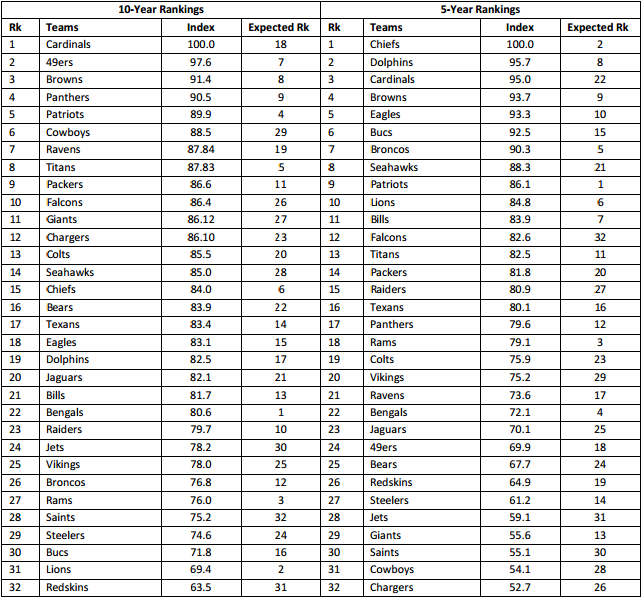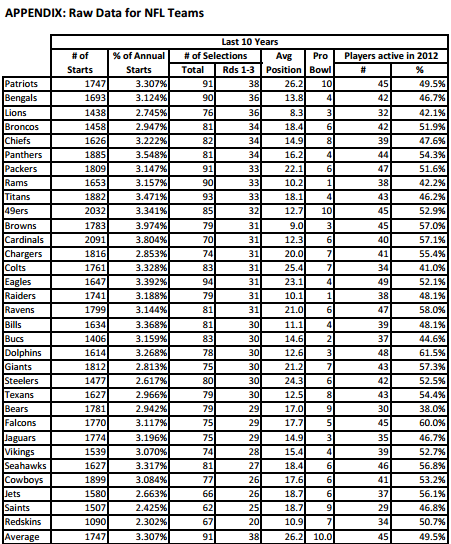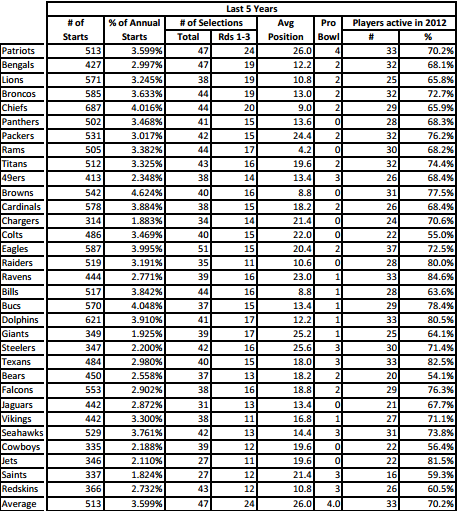Who's been doing the best job of drafting?
It has been my experience that perceptions usually have a basis in reality, but the perception lingers even as reality changes. Football is no exception to this phenomenon. Ask football fans about what teams drafts the best and you’re likely to get many different answers – the Steelers have a reputation as a good drafting team, so do the Giants. Are these perceptions right? In this article, DRAFTMETRICS sets aside its own perceptions and measures the draft performance of NFL teams over the past 10 years. This article focuses only a team’s drafting not their ability to retain their draftees. So, for example, the performance of Asante Samuel for the Eagles and Falcons accrues to the benefit of the Patriots because the Patriots drafted him.
The biggest obstacle in doing an objective analysis is to select the metrics that do the best job of measuring performances. DRAFTMETRICS decided to use a weighted combination of four measures to measure each team’s draft success.
• Total number of games started
THE MEASURE: The number of games started by each player drafted in his NFL career
PRO: Simplest measure to understand
CON: Earlier years are weighted more heavily than later years because a 2003 draftee has the opportunity to start more games than a player drafted in 2012
• Number of players active for the 2012 season
THE MEASURE: The number of players drafted that were active for the 2012 NFL season; players who missed the entire season due to injury are NOT counted
PRO: Measures the depth of a draft class
CON: Gives more emphasis to later years (players are more likely to still be active)
• Average share of annual starts
THE MEASURE: This is calculated by averaging each team’s percentage share of total
annual starts over the study period
-For example, the Bears 2003 draft class started 520 games, representing 5.8% of the 9040 total starts by the 2003 draft. This calculation was repeated for each team in each draft year and the results were then averaged for each team
PRO: All years are evenly weighted
CON: It’s a pretty geeky metric
• Pro Bowl
THE MEASURE: The number of drafted players who were selected for the Pro Bowl as
original selections; injury and other replacements don’t count
PRO: Gives credit for drafting the best players
CON: Tends to be weighted in favor earlier years as those players have more
opportunities to be selected
Each team’s total performance in the four measures was converted into an index with the top team receiving an index value of 100. DRAFTMETRICS will continue to revisit its measurement methodology and reserves the right to tweak that methodology as it thinks more about it. DRAFTMETRICS also thought it would be interesting to calculate a rough approximations of how the team’s should have performed in relation to each other using (1) the number of draft selections a team had in the top three rounds, (2) the total number of draft selections and (3) its draft position. A complete listing of the raw data used for each NFL team is included in the Appendix to this article. The following table shows the ranking (and expected ranking) by team for both the last 10 (2003-2012) and last five (2008-2012) years.

The Cardinals? Really? Yes. The Cardinals had excellent draft years in 2003 and 2004, selecting six players who have started over 100 NFL games (with their careers still in progress) and three more who have started at least 64 games. This list includes Cardinals mainstays such as Larry Fitzgerald and Darnell Dockett (who have combined to start 279 out of a possible 288 NFL games) and others such as Anquan Boldin, Calvin Pace, Karlos Dansby and Antonio Smith who were lost to other via free agency or trade. The biggest problem for the Cardinals is that there are no successful quarterbacks on that list.
Other highlights include:
• The best individual draft classes to date include the 2004 Chargers class, the 2008 Chiefs class and the Cowboys 2005 class.
-The Chargers 2004 draft class produced 617 starts and 4 Pro Bowl players
-The Chiefs 2008 class has six NFL starters, four of whom are still with the Chiefs
• The worst class by a team that had a first round draft choice is the Dolphins’ 2006 class
-57 total starts from the class
• Along with the Cardinals, the Falcons are probably the team that has performed best in the draft versus expectations
-Rated 10th in the 10-year review versus expected ranking of 26
-Rated 12th in the 5-year review versus expected ranking of 32
• As painful as it is for this long-time Steelers season ticket holder to admit, their draft performance has been weak
• The Lions 10-year performance versus expectations was the worst
-Ranked 31st versus expected ranking of 2nd
-The Rams weren’t much better with 27th ranking versus expected ranking of 3rd
-The Bengals join that group with 22nd ratings in both 10-year and 5-year reviews versus expected rating of 1st and 4th, respectively
• The Browns high ranking is driven by their 2011 and 2012 draft classes, with 198 games already
started by those two classes
-Bills are next highest with 145
• Expectations for the Patriots have been high despite their typical late drafting position
-Expectation was 4th in 10-year review and 1st in 5-year review
-High number of total and third round draft choices


# of Starts = Number of games started by players in applicable draft classes
% of Annual Starts = Average of each team's percentage share of total annual starts over the study period
# of Selections - Total = Number of draft choices during the study period
# of Selections - Rds 1-3 = Number of draft choices in the first three rounds during the study period
Average Position = A team's average first round draft position (excluding trades)
Pro Bowl = Number of players selected to the Pro Bowl (i.e., a player selected 3 times as counted as 1 Pro Bowl player)
Players Active in 2012 - # = Number of players drafted during the study period who played in the NFL in 2012
Players Active in 2012 - % = Number of Players Active in 2012 divided by # of Selections
Tony is the founder of DRAFTMETRICS.COM can be e-mailed at draftmetrics@gmail.com and followed on Twitter @draftmetrics